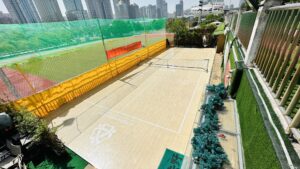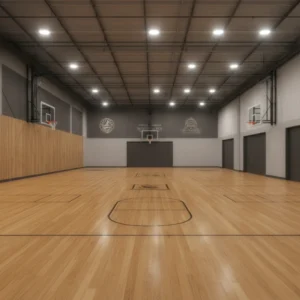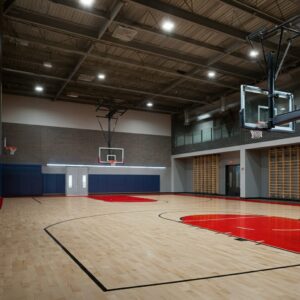Basketball is a popular sport that people of all ages worldwide enjoy. It is played on a court with specific dimensions, essential for ensuring that the game is played moderately and safely. The dimensions of a basketball half-court vary depending on the level of play and the age of the players.
This article will delve into the different dimensions of a basketball half-court and how they are used in the game.
Let’s start our discussion with the standard dimensions.
Standard Dimension
First, look at the dimensions of a standard half-court used in professional and college basketball. According to the National Basketball Association (NBA), the dimensions of a half-court are as follows:
- Length: 50 feet (15.24 meters)
- Width: 28 feet (8.53 meters)
Within these dimensions, a half-court is divided into sections.
Sections of Half-Court
The half-court is split into two sections: front and back.
The frontcourt is the court section closest to the basket and is marked by the half-court line.
While the backcourt is the section of the court that is farthest from the basket and is marked by the mid-court line.
Now, apart from the length and width dimensions, there are also several lines that further divide the basketball half-court. Let’s have a look at them.
Dimensions Other Than Length & Width
In addition to the length and width of the half-court, several other dimensions are important to know. These dimensions include
Free throw line:
15 feet (4.57 meters) from the backboard
Three-point line:
The distance from the basket varies depending on the level of play.
In the NBA, the distance is 23.75 feet (7.24 meters) from the center of the basket in the corners and 22 feet (6.7 meters) from the center of the basket along the top of the arc.
In college basketball, the distance is 20.75 feet (6.32 meters) from the center of the basket in the corners and 19.75 feet (6.02 meters) from the center of the basket along the top of the arc.
Lane:
The lane, also known as the key or paint, is the area directly under the basket and extends 16 feet (4.88 meters) from the basket on each side. The free-throw line and the baseline mark the lane.
Baseline:
The baseline is the line that marks the end of the court and extends from the basket on one end to the basket on the other end.
That’s a lot, right? But why are all these dimensions important?
Here we go with the answer!!!
Why are these extra dimensions critical?
These dimensions are critical because they dictate where players can and cannot go on the court.
For example, players are not allowed to step on the free throw line when attempting a free throw and must remain behind the three-point line when trying a three-point shot. The lane is reserved for players attempting to score near the basket and is often congested with players jockeying for position.
But remember that using these same dimensions is not a hard and fast rule. There are also some other options you can use. Let’s have a look at them.
Backyard Basketball Half-Court Dimensions and Options
If you’re planning to set up a basketball half-court in your backyard, there are a few options regarding dimensions.
One option: Use the Exact Dimensions as a Standard Half-Court:
A standard half-court is 50 feet long and 28 feet wide. This option is good if you have a large enough space to accommodate these dimensions and if you plan to play a serious basketball game. However, if you don’t have a lot of space or just want to play a casual game, consider using smaller dimensions.
Option 2: Use Mini Basketball Hoop Dimensions:
Mini basketball hoops are smaller versions of standard basketball hoops and are often used for children or casual play. The dimensions of a mini basketball hoop vary depending on the size of the hoop, but they are generally much smaller than a standard half-court. For example, a mini basketball hoop may have a playing area that is 15 feet long and 8 feet wide.
Option 3: Use Adjustable Basketball Hoop Dimensions.
Adjustable basketball hoops allow you to adjust the height of the hoop, making them suitable for players of all ages and skill levels. The dimensions of an adjustable basketball hoop depend on the size of the hoop and the range of the adjustable height. Still, they are generally larger than mini basketball hoops and smaller than a standard half-court.
But before choosing any one of these options, you must keep a key point in mind.
Key Point
No matter what dimensions you choose, it’s essential to ensure that you have enough space to play safely and comfortably. Be sure to consider the size of your backyard and any obstacles that may be in the way. You should also ensure enough room to move around the court and shoot the ball without hitting any objects or people.
Now that you know the basketball court dimensions let’s talk a little about the overhang distance of the backboard.
Basketball Backboard Overhang Distance
The overhang distance of a basketball backboard is the distance between the backboard and the plane of the playing surface. The overhang distance is important because it determines how close a player can get to the backboard when attempting a shot.
According to the National Basketball Association (NBA):
The overhang distance for a regulation backboard is 6 inches (15.24 centimeters). This means that the backboard extends 6 inches beyond the plane of the playing surface. The overhang distance is measured from the bottom of the backboard to the plane of the playing surface.
Let’s see the significance of overhang distance in basketball gameplay.
Why is Overhang Distance significant?
The overhang distance enforces rules related to goaltending and basket interference. Goaltending occurs when a player blocks a shot on its downward flight toward the basket. Basket interference occurs when a player touches the ball or the rim while the ball is in the basket or on its way to the basket. These rules help to ensure that players cannot interfere with shots that are in the process of being attempted.
In addition to its role in enforcing rules, the overhang distance of the backboard is also vital for player safety. The overhang distance allows players to get close to the basket without running into the backboard, which could result in injury.
There’s also a key point to note here.
Key Point:
It’s important to note that the overhang distance for a backyard basketball hoop may differ from that for a regulation backboard. Backyard hoops are typically smaller than regulation hoops and may have a different overhang distance. Check the dimensions of your hoop to ensure that it meets any applicable safety standards.
Which Material Should you use to create Half Court?
In addition to the court’s dimensions, you’ll also need to consider the materials you’ll use to create your half-court.
Option 1: Use a permanent surface such as concrete or asphalt.
Concrete and asphalt are the most common materials used for making outdoor courts. These surfaces are durable and long-lasting but can damage the joints because of their hardness.
Option 2: Use a removable surface such as a mat or tiles.
Another option is to use a portable basketball hoop and a removable surface such as a mat or tiles. Portable hoops are easy to set up and take down and can be moved to different locations as needed.
Removable surfaces are also easy to install and take down, and they can be used to create a temporary playing area on any flat surface. One of the best tiles for making professional basketball courts is the Gamechanger+ from Copo Sports.
Key Point:
No matter what dimensions you choose and the materials you use, ensuring that your half-court is safe and well-maintained is essential. Be sure to check the condition of your hoop and net regularly and make necessary repairs or replacements. You should also keep the playing surface clean and clear of debris to ensure it is safe.
Now let’s see some FAQs before we finish our guide.
FAQs
How much space do you need for a half-court basketball?
To set up a half-court basketball, you will need a space at least 50 feet long and 28 feet wide. These dimensions are based on the standard dimensions of a half-court used in professional and college basketball.
The Bottom Line
Basketball is one of the most liked games around the globe. But to enjoy the game fully, you need a half-court with specific dimensions.
In this brief guide, we’ve covered everything you need to know about the basketball half-court dimensions.









